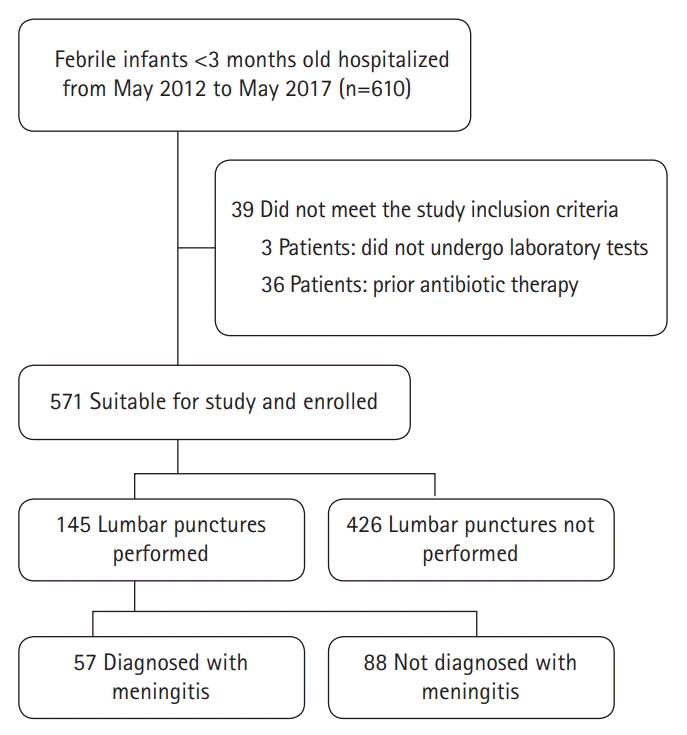1. Pulliam PN, Attia MW, Cronan KM. C-reactive protein in febrile children 1 to 36 months of age with clinically undetectable serious bacterial infection. Paediatrics. 2001; 108:1275–9.

2. Olaciregui I, Hernandez U, Munoz JA, Emparanza JI, Landa JJ. Markers that predict serious bacterial infection in infants under 3 months of age presenting with fever of unknown origin. Arch Dis Child. 2009; 94:501–5.

3. Van den Bruel A, Thompson MJ, Haj-Hassan T, Stevens R, Moll H. Diagnostic value of laboratory tests in identifying serious infections in febrile children: systemic review. BMJ. 2011; 342:d3082.
4. Bilavsky E, Yarden-Bilavsky H, Ashkenazi S, Amir J. C-reactive protein as a marker of serious bacterial infections in hospitalized febrile infants. Acta Paediatr. 2009; 98:1776–80.

5. Baraff LJ. Outpatient management of fever in selected infants. N Engl J Med. 1994; 330:938–9.

6. Dagan R, Powell KR, Hall CB, Menegus MA. Identification of infants unlikely to have serious bacterial infection although hospitalized for suspected sepsis. J Pediatr. 1985; 107:855–60.

7. Sturgeon JP, Zanetti B, Lindo D. C-reactive protein (CRP) levels in neonatal meningitis in England: an analysis of national variations in CRP cut-offs for lumbar puncture. BMC Pediatrics. 2018; 18:380.

8. Polin RA. Management of neonates with suspected or proven early-onset bacterial sepsis. Pediatrics. 2012; 129:1006–15.

9. Jaye DL, Waites KB. Clinical applications of C-reactive protein in pediatrics. Pediatr Infect Dis J. 1997; 16:735–46.

10. Du Clos TW. Function of C-reactive protein. Ann Med. 2000; 32:274–8.

11. National Institute for Health and Clinical Excellence (NICE). Neonatal infection (early onset): antibiotics for prevention and treatment. Clinical guideline [CG149] [Internet]. Manchester: NICE;2012. [cited 2019 Dec 14].
http://www.nice.org.uk/guidance/cg149/.
12. Kelly C, Sohal A, Michael BD, Riordan A, Solomon T, Kneen R, et al. Suboptimal management of central nervous system infections in children: a multi-centre retrospective study. BMC Pediatr. 2012; 12:145.

13. Milcent K, Faesch S, Gras-Le Guen C, Dubos F, Poulalhon C, Badier I, et al. Use of procalcitonin assays to predict serious bacterial infection in young febrile infants. JAMA Pediatr. 2016; 170:62–9.

14. Woll C, Neuman MI, Aronson PL. Management of the febrile young infant: update for the 21st century. Pediatr Emerg Care. 2017; 33:748–53.
15. Maniaci V, Dauber A, Weiss S, Nylen E, Becker KL, Bachur R. Procalcitonin in young febrile infants for the detection of serious bacterial infections. Pediatrics. 2008; 122:701–10.

16. Khilnani P, Deopujari S, Carcillo J. Recent advances in sepsis and septic shock. Indian J Pediatr. 2008; 75:821–30.

17. Manzano S, Bailey B, Girodias JB, Galetto-Lacour A, Cousineau J, Delvin E. Impact of procalcitonin on the management of children aged 1 to 36 months presenting with fever without source: a randomized controlled trial. Am J Emerg Med. 2010; 28:647–53.

18. Gajdos V, Foix L'Helias L, Mollet-Boudjemline A, Perreaux F, Trioche P, Labrune P. Factors predicting serious bacterial infections in febrile infants less than three months old: multivariate analysis. Arch Pediatr. 2005; 12:397–403.
19. Schroeder S, Hochreiter M, Koehler T, Schweiger AM, Bein B, Keck FS, et al. Procalcitonin (PCT)-guided algorithm reduces length of antibiotic treatment in surgical intensive care patients with severe sepsis: results of a prospective randomized study. Langenbecks Arch Surg. 2009; 394:221–6.

20. Rey C, Los Arcos M, Concha A, Medina A, Prieto S, Martinez P, et al. Procalcitonin and C-reactive protein as markers of systemic inflammatory response syndrome severity in critically ill children. Intensive Care Med. 2007; 33:477–84.

21. Konstantinidis T, Cassimos D, Gioka T, Tsigalou C, Parasidis T, Alexandropoulou I, et al. Can procalcitonin in cerebrospinal fluid be a diagnostic tool for meningitis. J Clin Lab Anal. 2015; 29:169–74.

22. Prasad R, Kapoor R, Mishra OP, Srivastava R, Kant Singh U. Serum procalcitonin in septic meningitis. Indian J Pediatr. 2013; 80:365–70.

23. Hur M, Moon HW, Yun YM, Kim KH, Kim HS, Lee KM. Comparison of diagnostic utility between procalcitonin and C-reactive protein for the patients with blood culture-positive sepsis. Korean J Lab Med. 2009; 29:529–35.

24. Kim EK, Lee BS, Lee JA, Jo HS, Park JD, Kim BI, et al. Clinical availability of serum procalcitonin level in the diagnosis of neonatal bacterial infection. J Korean Soc Neonatol. 2001; 8:211–21.
25. Kim NH, Kim JH, Lee TJ. Diagnostic value of serum procalcitonin in febrile infants under 6 months of age for the detection of bacterial infections. Korean J Pediatr Infect Dis. 2009; 16:142–9.






 PDF
PDF Citation
Citation Print
Print




 XML Download
XML Download